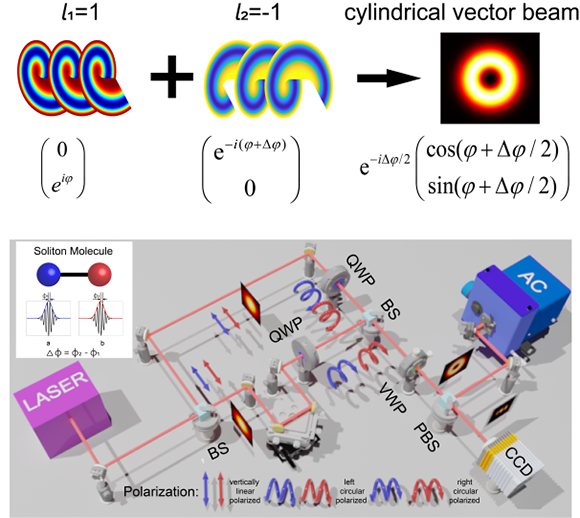Solitons, non-spreading wave structures, are universal in a variety of research fields that ranging from fluid and condensed matter physics to chemistry and neurobiology. Optical solitons can be formed and propagated in laser cavities with remarkable stability thanks to a double balance between loss and gain and between dispersion and nonlinearity. Optical solitons show particle-like interactions and can form various bound states akin to chemical molecules, which are frequently referred as soliton molecules. Soliton molecules have attracted tremendous attention due to their potential to upgrade the transmission capability of optical communication and to demonstrate complex soliton interaction behaviors in dynamical nonlinear systems.
Stationary femtosecond soliton molecules with constant binding separation and relative phase have long been proved to exist in various laser configurations based on optical spectral analysis, while the time-averaged measurements based on optical spectral analyzers hinder the observation of more complex soliton molecular dynamics. Recently, a time-stretch dispersive Fourier transform (DFT) technique has been frequently utilized to unveil the shot-to-shot evolution of soliton molecular spectra, enabling the identification of different kinds of vibrating and oscillating modes in soliton molecules.
Prof. Minglie Hu and Prof. Youjian Song from the Ultrafast Laser Laboratory at Tianjin University notice that while the DFT technique is very appealing for probing the transient properties within soliton molecules, the observation time frame is limited to hundreds of microseconds, mainly confined by the storage capability of the real time oscilloscopes. "A long-term phase evolution description of soliton molecules is still missing to date and calls for advanced ultrafast characterization approaches." says Prof. Hu.

Orbital angular momentum (OAM)-resolved method to unveil the internal phase motions within soliton molecule
Prof. Hu and his team proposed a new diagnostic, orbital angular momentum (OAM)-resolved method, which is capable of visualizing the complex internal phase motion of soliton molecules over a long period. Related research results are reported in Photonics Research, Vol. 8, Issue 10, 2020 (Yuwei Zhao, Jintao Fan, Youjian Song, Uwe Morgner, Minglie Hu. Extraction of internal phase motions in femtosecond soliton molecules using an orbital-angular-momentum-resolved method[J]. Photonics Research, 2020, 8(10): 10001580.).
Temporal varying phases within soliton molecules were transformed to the spatial phase difference between two optical vortices with opposite topological charges. As a consequence, by using a fast frame rate CCD camera to monitor the rotational movement of the combined vortices, the complex internal motion of soliton molecules in terms of relative phase evolution can be monitored over a long period.
Prof. Song explains, "By means of the OAM-resolved method, the long-term relative phase evolution of doublet and triplet soliton molecules with different bind separations produced by a femtosecond Er-doped mode-locked fiber laser can be successfully resolved." Prof. Hu points out that various soliton molecule states with stationary and monotonically evolving phase can be easily characterized by overlapping the solitons properly.
Prof. Hu and his team expect that such a practical, low-cost and simple diagnostic method provides a new idea for visualizing the complex internal phase dynamics in dissipative systems. Moreover, the OAM-resolved method is capable to transfer the temporal phase of soliton pairs to the spatial phase of vector beams, thus they anticipate that the proposed setup holds the potential to trap and control the rotation of nanoparticles via manipulating soliton-molecular relative phases.
The method is novel, interesting and timely. It will provide new direct visualization tool to study phase dynamics in various transient phenomena, thus the paper will attract wide attention.


